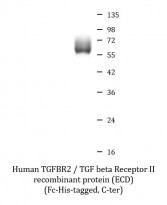ARG70284
Human TGFBR2 / TGF beta Receptor II recombinant protein (ECD) (Fc-His-tagged, C-ter)
Human TGFBR2 / TGF beta Receptor II recombinant protein (ECD) (Fc-His-tagged, C-ter) for Binding Activity,SDS-PAGE and Human
Overview
| Product Description | HEK293 expressed, Fc-His-tagged (C-ter) Human TGFBR2 / TGF beta Receptor II recombinant protein (ECD). |
|---|---|
| Tested Reactivity | Hu |
| Tested Application | Binding, SDS-PAGE |
| Target Name | TGFBR2 / TGF beta Receptor II (ECD) |
| Species | Human |
| A.A. Sequence | Thr23 - Asp159 of Human TGFBR2 / TGF beta Receptor II (NP_003233.4) with an Fc-6X His tag at the C-terminus. |
| Expression System | HEK293 |
| Alternate Names | FAA3; AAT3; TbetaR-II; TGF-beta receptor type-2; LDS2B; MFS2; TGF-beta type II receptor; EC 2.7.11.30; TAAD2; TGFR-2; LDS2; Transforming growth factor-beta receptor type II; TGFbeta-RII; TGF-beta receptor type II; RIIC; LDS1B |
Application Instructions
| Application Note | Binding activity test: Measured by its binding ability in a functional ELISA. Immobilized recombinant human TGFB1 at 2 ug/ml (100 µl/well) can bind recombinant human TGFBR2 with a linear range of 1-5 ng/ml. |
|---|
Properties
| Form | Powder |
|---|---|
| Purification Note | 0.22 µm filter sterilized. Endotoxin level is <0.1 EU/µg of the protein, as determined by the LAL test. |
| Purity | >95% (by SDS-PAGE) |
| Buffer | PBS (pH 7.4) |
| Reconstitution | Reconstitute to a concentration of 0.1 - 0.5 mg/ml in sterile distilled water. |
| Storage Instruction | For long term, lyophilized protein should be stored at -20°C or -80°C. After reconstitution, aliquot and store at -20°C for up to one month, at 2-8°C for up to one week. Storage in frost free freezers is not recommended. Avoid repeated freeze/thaw cycles. Suggest spin the vial prior to opening. |
| Note | For laboratory research only, not for drug, diagnostic or other use. |
Bioinformation
| Gene Symbol | TGFBR2 |
|---|---|
| Gene Full Name | transforming growth factor, beta receptor II (70/80kDa) |
| Function | Transmembrane serine/threonine kinase forming with the TGF-beta type I serine/threonine kinase receptor, TGFBR1, the non-promiscuous receptor for the TGF-beta cytokines TGFB1, TGFB2 and TGFB3. Transduces the TGFB1, TGFB2 and TGFB3 signal from the cell surface to the cytoplasm and is thus regulating a plethora of physiological and pathological processes including cell cycle arrest in epithelial and hematopoietic cells, control of mesenchymal cell proliferation and differentiation, wound healing, extracellular matrix production, immunosuppression and carcinogenesis. The formation of the receptor complex composed of 2 TGFBR1 and 2 TGFBR2 molecules symmetrically bound to the cytokine dimer results in the phosphorylation and the activation of TGFRB1 by the constitutively active TGFBR2. Activated TGFBR1 phosphorylates SMAD2 which dissociates from the receptor and interacts with SMAD4. The SMAD2-SMAD4 complex is subsequently translocated to the nucleus where it modulates the transcription of the TGF-beta-regulated genes. This constitutes the canonical SMAD-dependent TGF-beta signaling cascade. Also involved in non-canonical, SMAD-independent TGF-beta signaling pathways. [UniProt] |
| Cellular Localization | Cell membrane; Single-pass type I membrane protein. Membrane raft. [UniProt] |
| Calculated MW | 65 kDa |
| PTM | Phosphorylated on a Ser/Thr residue in the cytoplasmic domain. [UniProt] |
Images (1) Click the Picture to Zoom In






